When Hernan Cortes and his men reached the capital of the Aztec nation to meet Moctezuma, he saw a powerful, shining city spread across the islands of Lake Texcoco. Tenochtitlán had a population of over 200,000 during the time of the conquistadors - more than the then European metropolises. But the newcomers were greeted with something else ... A monstrous stench.
On November 8, 1519, the Spaniards reached the heart of the Aztec state. Before them, on the water of the salt lake of Texcoco, stood a great city, connected to the mainland by dikes. They were crossed by bridges under which boats could pass and which could be raised, e.g. for defense purposes.
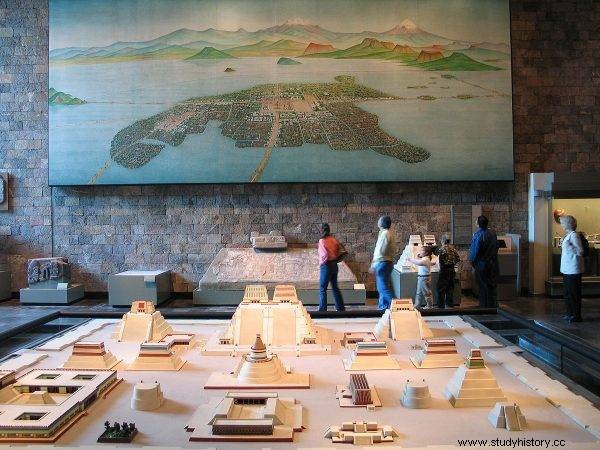
A model of Tenochtitlán in the National Museum of Anthropology in Mexico.
The washing water was provided by two double terracotta aqueducts. Each was over 4 km long and supplied water from Chapultepec Hill. Drinking water was supplied to the city from mountain streams. The Spaniards were impressed by the size and panache of the capital. They encountered wide, comfortable thoroughfares full of people, great pyramids, palaces and floating gardens, as well as a ritual center surrounded by a 2.5-meter wall. The 60-meter Templo Mayor - a pyramid with two temples towered above everything. Participant of the expedition, Bernal Díaz del Castillo, wrote:
There were so many tall towers and temples and buildings rising straight from the water, all made of stone, that some of our soldiers asked if what we see is not a dream . It is no wonder that I am writing about it this way, even minimizing many things, because I do not know how to express them:for we have seen things that have never been seen or heard of! (…)
We made our way along a causeway eight paces wide, which leads straight to Mexico City without deviating too much. Although it was so wide, it was full of people:some were going to Mexico, others were coming back, and since there were many Indians who came out to watch us, it was difficult to get through. The towers, temples, boats on the lake on all sides were full of interesting, no wonder, because they had never seen horses or people like us.
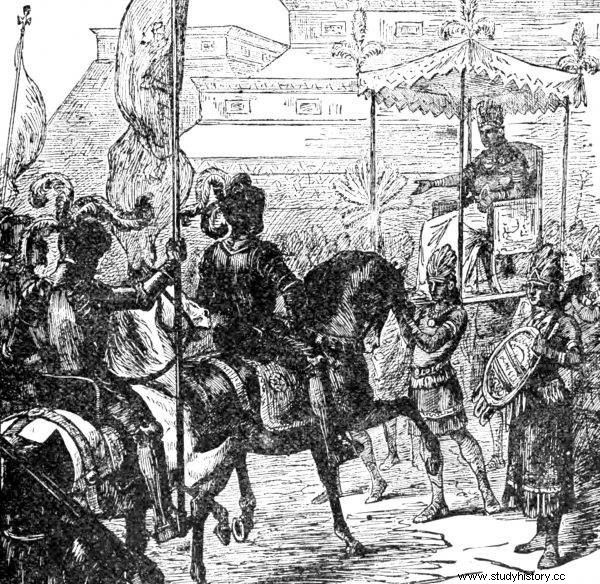
photo:Ober, Frederick A. (Frederick Albion), 1849-1913 / public domain A meeting of Cortez and Moctezuma
Europeans were received with honors. Glamor awaited them. Maurice Collis in the book Cortes and Montezuma. describes:
The palace where they were quartered consisted of several buildings of stone whitewashed and polished to sparkle. He had many spacious rooms, very clean and lined with painted cotton fabrics.
There were also courtyards, swimming pools, fountains and gardens in the complex. The city was spread out all around. (...) houses made of volcanic stones, with flat roofs, streets - just like in Amsterdam or Venice - crisscrossed with canals, palaces and temple pyramids everywhere. In fact, it was one of the largest and most beautiful cities in the world.
Díaz del Castillo noted in his diary that the hospitality of the Indians did not lull the Spanish vigilance:
As we entered the great courtyard, Montezuma, who was waiting for us there, took Cortez by the arm and led him to the rooms where he was to live. They were very richly dressed for this purpose, he also prepared a very rich, elaborate necklace of golden crabs and personally put it around the neck of Cortez, which his chieftains marveled as too much honorable. Then he retired to his palaces nearby.
We placed our troops in the halls, the artillery was set in the right place, the exact order was determined, which we were supposed to stick to, always on alert, both riders and everyone else other soldiers. According to the local custom, we were served a hearty meal.
Moctezuma's Zoo
The first days in the heart of the Aztec country were spent by the Spaniards in palace complexes. Diaz described the delightful but terrifying wonders of the Aztec capital - for example, an aviary where thousands of birds were bred - from giant eagles to hummingbirds. The animals were regularly plucked to obtain beautiful feathers that adorned the clothes and heads of nobles. There were also large predators in the palace zoo. Del Castillo recalled:
all kinds of predatory beasts, tigers, two kinds of lions, wolf-like animals here called jackals, and foxes, and other smaller predators. They were all fed meat, most of them were born in this building, they were given the meat of goats, chickens, little dogs, other game animals, and even, I heard, the bodies of Indians killed as a sacrifice.
Del Castillo had seen jaguars, pumas, and other South American animals that he did not know. Therefore, because of the similarity, he called them lions and tigers. He also disgustedly described:
Moreover, in that damned building there were many vipers and rattlesnakes with little bells around their necks - they are the most poisonous of all, and kept in vats and huge pots full of feathers, there they laid their eggs and brought forth little ones; they were fed the meat of Indians killed as a sacrifice of the dogs they breed there . How terrifying it was when tigers and lions howled, jackals and foxes howled, snakes hissed - it was terrible to hear it, it felt like hell!
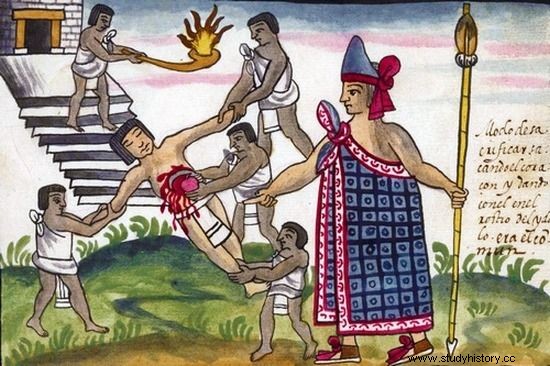
Diaz described the delightful but also terrifying wonders of the Aztec capital.
On the other hand, the Cortes soldier could not praise the craftsmanship of Indian goldsmiths, stonemasons and other craftsmen. It also faded over the beauty of the royal estates:
Let us not forget the flower gardens, the fragrant trees, of which it has many of all kinds, and the walks among them, the pools and pools of freshwater where water flows from one the end, and it flows from the other, about bathing in them, about the variety of little birds that chirp among the trees, one would see, many medicinal herbs, and how he uses them.
There are numerous gardeners and everything - bathing areas, paths, and patio, and gazebos and stages where they dance and sing - are made of stone and beautifully whitened. There was so much to admire in the gardens and everywhere that we were amazed at the great splendor of Moctezuma .
Boats full of dung
Shortly after arriving in the city, Cortes set off to visit Tenochtitlán outside the palace. Montezuma was with him. The Aztec capital was distinguished not only by the beauty of the building, but also by its clear urban layout. The city was divided into quarters, which were additionally divided into "housing estates" - calpulli . Each estate had its own tiyanquiztli - the market where people met and traded.
"In the great Tatelulco square we were amazed, because we had never seen such a crowd of people and such a lot of goods, we were amazed at the great order and supervision ” - recalled Diaz. There were people here. He estimated their number at tens of thousands. Everything was sold - from jewelry, through utensils, slaves, weapons, animals, agricultural produce, to… human faeces. The chronicler wrote:
Lots of boats filled with human waste, sorry to write about this, are moored around the square:this merchandise is used to make alum and tan hides (…). I know some readers will laugh at this, but that's what I say. I will also say that it is customary to build small huts of reeds, grasses and straw along the way, where passersby can stop without being seen, and take refuge there if they have to empty their lives, and this impurity will not be lost .
Bloodthirsty gods
From the square, the Europeans' tour, under the watchful eye of the Indians, climbed 114 steps to the top of the great Templo Mayor temple, where, as Diaz describes, hideous images of deities and fresh bloodstains awaited them. However, there was a beautiful view of the Aztec capital from the top:
We saw the three dykes leading to Mexico from there (…). We saw fresh water flowing from Chapultepec to supply the city, and on these three dikes at regular intervals under which the water of the lake flowed from one side to the other. We saw a lot of boats on that great lake, some bringing food, others returning with cargo and goods.
We saw that in a city, as in all cities built on water, it was impossible to move from house to house other than by wooden drawbridges or by boats. We saw (...) churches and sanctuaries in the shape of towers and strongholds, all shining white to admiration, and other towers and chapels stood at the houses, in the streets and on dikes, creating small strongholds .
Here, at the top of the pyramid, from where this breathtaking sight was, there were bloody rites that terrified Catholic Spaniards. The Templo Mayor's 60-meter pyramid was flowing with blood every day. The Aztecs believed that their main deity, Huitzilopochtli, is born again every dawn and dies at sunset.
Being a god - the sun crossing the sky - it needed strength for its journey. Therefore, they had to be fed with the blood of the people being sacrificed and still beating hearts torn from their chests .
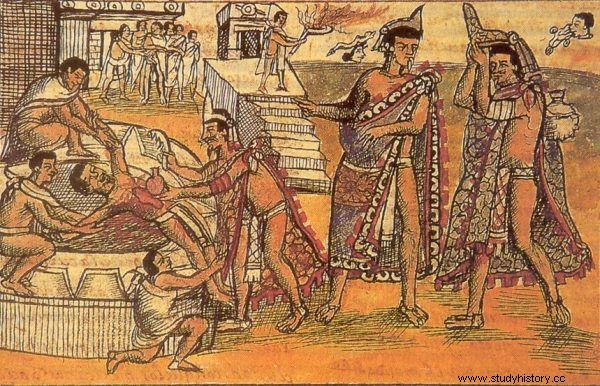
Here, at the top of the pyramid, from where this breathtaking sight was, there were bloody rites that terrified Catholic Spaniards.
In the vicinity of the Templo Mayor rising above the sky, there was a tzompantli - a 52 × 22 × 9 m tank filled with the skulls of the dead. The Aztecs were particularly proud of it. It was a material proof of their work to save the world from destruction.
Prisoners (not only them, but also children) were killed in various ways - depending on the deity to whom they were dedicated. For example, Tezcatlipoc, the god of darkness and war, could only be a brave, battle-hardened warrior. For a year before his heart was ripped out, he was treated like an incarnation of God. He lived in luxury and respect. He surrounded himself with service and a wreath of wives.
Those who were sacrificed to the god of fire - Huehueteotlcie had much worse. These unfortunates were first thrown into the fire, then dragged into the flames while still alive and their hearts torn out . To complete the macabre, let us add that the sacrificed thighs and arms were eaten during sumptuous, solemn feasts.
As the chronicler del Castillo recalls, the interior of the Aztec temples in Tenochtitlán was filled with an amazing smell of congealed blood , larger than the largest slaughterhouses of Castile. Blood was everywhere, soaking into floors, walls. Under the statues of deities - misshapen mascaras, decorated with precious jewels, lay the hearts of the unfortunates murdered that day:
And since everything in this slaughterhouse smelled like we couldn't wait to get out of here and we would not be left to the stuffiness and the sight of it, so our leader through our translator, he said in half, smiling:
"Mr. Montezuma, I do not understand how such a great ruler and wise man as your love did not recognize in his mind that these gods are not gods but creatures damned, called devils, and for your love and all your priests to convince themselves of this, please grant us a grace: allow me to place a cross on the top of this tower, and in one corner of the sanctuary, where your Uichilobos and Tezcatepuca stand , made a fence in which we will place the image of Our Lady, Mother of God (which Montezuma has already seen this picture), and you will see what terror will seize those gods who deceive you. '
The two priests present there showed great dissatisfaction, and Moctezuma half angrily said, "If I had known that you would so insult my gods, I would not have shown them to you. We honor them as good, they give us health and water and seeds and weather and victories as much as we want. We should honor and sacrifice them. Therefore, I am asking you to give up other words in their image. "
Cortes, seeing that the atmosphere became tense, tried to smooth the situation and apologized for being tactless, however, Montezuma was forced to tame the gods who had been insulted. To this end, he stayed in the temple to make sacrifices. Meanwhile, the Spaniards realized that there were many more such macabre spaces in Tenochtitlán. Del Castillo described:
At some distance from the great temple stood a small turret, which was at the same time the seat of idols and a real hell, for the entrance to it was a terrible maw, which they paint to represent hell, mouth open, armed fangs to devour souls.
There were figures of devils and snakes at the gate as well, a sacrificial table nearby, all covered in blood and black with smoke and blood clots. There were many large vats, jars and jars full of water, in which the meat of the unfortunate Indians was cooked, eaten by priests, at the sacrificial table there were many knives, a few butcher's trunks made of wood, similar to the slaughterhouse .
La Noce Triste
Montezuma lost the psychological game with Cortes. Despite the awareness he had acquired over time - that the Spanish commander was not an incarnation of Quetzalcoatl, but a man - he was unable to oppose him. By persuasion Cortes forced the ruler to hand over the chambers in the royal palace to the soldiers. This way the Spaniards had it in hand.
Soon he became their prisoner and hostage. They forced him to recognize the sovereignty of the Spanish crown. He agreed to build a Catholic chapel in Tenochtitlán and stop the bloody rites. As a gift for the Spanish king, he gave the visitors a palace treasure - a chamber full of gold. Soon after, a cross and a Catholic image appeared in the temple of bloody deities at Moctezuma's palace. Contrary to Moctezuma, the image of the Virgin Mary appeared on the top of Templo Mayor.
When Cortes left the city in 1520, the Aztecs announced the organization of religious ceremonies on the Templo Mayor. The Spaniards agreed to the rites, but no human sacrifice. Soon after, however, fearing an Aztec uprising, they launched a preventive strike. Bloody pacification turned into rebellion. Cortes, who meanwhile returned to Tenochtitlán, forced Moctezuma to appear in public before the Indians and to try to ease the mood. It failed. Thrown with stones and shot with bows, the ruler died shortly after.
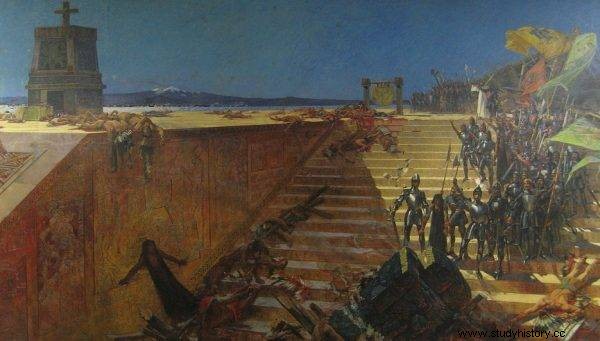
Moctezuma agreed to the construction of a Catholic chapel in Tenochtitlán and the cessation of bloody rites.
Cortes realized that after the bridges over the dikes were closed, Tenochtitlán would become their prison. He also knew that they had to escape under cover of night. That's why he had makeshift portable bridges built. Nevertheless, the escape from the city turned into a slaughter of the Spaniards. Carts with gold stuck to the marshy dikes. Panic broke out in the ranks of the conquistadors, showered with arrows . Many refugees - including Cortes himself - had to save themselves by crossing the lake by swimming. The gold and other valuables taken out of the city fell into the water. Many Spaniards, burdened with valuables, drowned during their escape. Those captured ended up with a sacrificial stone.
During La Noce Triste, from 150 to even over 400 Spaniards and several thousand Tlaxalans - Indians allied to the conquistadors - were killed. The Europeans have lost all their valuables, most of the artillery and horses.
Ultimately, however, was the end of the Aztec world and thus the end of the beautiful and terrifying capital city of Tenochtitlán. An epidemic of smallpox, an unknown disease among Indians, decimated their ranks. Cortes himself was not only unbreakable commanding a weakened unit after La Noce Trista, but soon returned with a stronger army, backed by Indian allies. He finally conquered Tenochtitlán on August 13, 1521, after several months of bloody battles with the Aztecs. After breaking into the capital, the Spaniards and their Indians allied with them plundered the city and murdered the inhabitants for four days.
Soon after, they began destroying all artifacts of Aztec culture, including Tenochtitlán itself. The Templo Mayor and other temples were demolished. Christian churches were built on their ruins. Lake Texcoco was gradually drained over the decades. It was the end of the Latin American Indian world, because soon after the Spaniards subjugated all the tribes, and the end of the great Mesoamerican metropolis - a miracle of technology, engineering, and architecture - larger and more magnificent than the most powerful cities of Europe at the time.
Bibliography:
- Maurice Collis, "Cortez i Montezuma", Wydawnictwo Dolnośląskie 2004.
- Bernal Díaz del Castillo, "Diary of a soldier Kortez, or the true story of the conquest of New Spain", Warsaw 1962.
